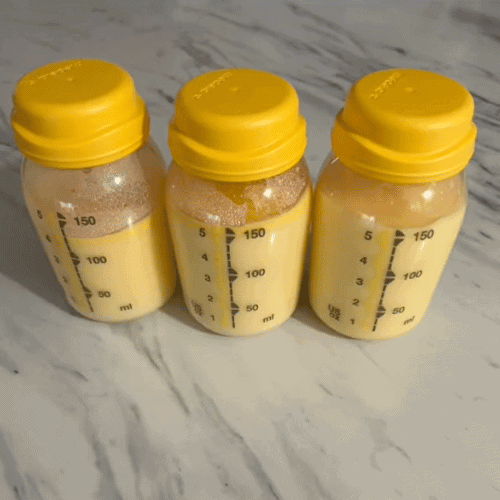Have you ever heard of colostrum before? Colostrum is considered the first milk the mother produces after giving birth, which has important health benefits for newborn babies. But what does colostrum look like?
This article will discuss colostrum’s benefits and how its appearance and consistency define its quality.
Colostrum Appearance Description
The color palette of colostrum varies from a striking golden yellow to a deeper, vibrant orange. Its opacity gives it a rich and full-bodied look.
This warm, radiant hue highlights its uniqueness, making colostrum easily distinguishable from mature breast milk.
Visual Appearance of Colostrum
Color of Colostrum

Colostrum has a yellowish color (sometimes with an orange hue) which is due to its high levels of beta-carotene, though in some cases it may appear paler or clearer. It’s often sticky and can contain faint traces of blood, though this is normal.
We asked a lactation consultant to describe the appearance of colostrum and this is what she said:
Colostrum appears as a thick, sometimes almost sticky fluid, with a consistency similar to heavy cream or even custard. Its color ranges from golden yellow to deep orange, often described as “liquid gold”.
It is opaque, with a vibrant, warm hue that speaks to its richness in nutrients and antibodies. Each drop is packed with life-protecting components, essential for a newborn’s health.
The color and texture make colostrum uniquely identifiable in its vital role.
Consistency of Colostrum

Colostrum has a thicker and creamier consistency than transitional and mature milk, which are thinner and more watery. This consistency is due to the high amount of proteins and other essential nutrients present.
Like the changes in color and appearance, colostrum eventually thins out after a few days as it transitions to transitional and mature breast milk.
Consult a healthcare professional or a lactation consultant if you have questions about your colostrum’s appearance

Changes in Colostrum Over Time
Two to five days after childbirth, colostrum transitions to transitional milk and eventually mature milk. It takes 5-14 days to produce transitional breast milk, while it takes 2 weeks postpartum to begin the production of mature milk production.
The consistency also becomes thinner and the color becomes a clearer shade of white or even bluish as the milk transitions.
Physical Changes
As the colostrum changes to transitional milk, the mother’s breasts will start to firm, tender, and full, while the baby’s stomach expands to allow them to take more milk with each feeding. Once the milk supply is established and the body stabilized, the milk starts to mature.
Misconceptions About Production & Appearance
Contrary to popular belief, colostrum’s hue or consistency doesn’t its efficiency. Its properties remain beneficial regardless of color, consistency, and amount. Being potent and nutrient-dense, even small amounts of colostrum can already benefit newborns.
These factors may vary greatly among mothers but isn’t usually a problem.
Understanding Colostrum
Colostrum is released by the mammary glands after giving birth and is the first form of breast milk that your baby will get through breastfeeding. Mammals generate colostrum just prior to giving birth and it’s especially rich in bioactive compounds that will greatly benefit newborn babies.
Key Components & Benefits of Colostrum
Colostrum is rich in proteins and nutrients that benefit infant growth and development. Even in small doses, It’s highly concentrated and nutrient-dense. It’s composed of the following:
- Immunoglobulins – Immunoglobulins or antibodies are glycoprotein molecules produced by plasma cells (white blood cells) and used by the immune system to identify and neutralize foreign objects like germs, viruses, and bacteria.
- Lactoferrin – Lactoferrin is a protein found in human/animal milk and other bodily fluids that helps regulate how well the body absorbs iron from the intestine. It supports the immune response and has immune-modulatory effects, which promote an antiviral response to cope with immune stressors and benefit immune health altogether.
- Lysozyme – Lysozyme is a protein present in the tears, saliva, mucus, and tissues of animals and plants. It plays an important role in the immune system, providing protection against bacteria, viruses, and fungi and even anti-inflammatory effects.
- Leukocytes – White blood cells, also known as leukocytes, are responsible for protecting your body from infection and dangerous cells. Leukocytes can also produce antibodies that circulate through the bloodstream.
- Growth factors – Growth factors are naturally occurring proteins responsible for regulating processes like wound healing, muscle synthesis, skin elasticity, and cell regeneration.
It’s also rich in vitamins A, C, and K, magnesium, and beta-carotene, which gives its yellowish color.
Difference Between Colostrum vs. Breast Milk
Breast milk develops into three stages and changes days after childbirth:
- Colostrum – The first phase of breast milk. it changes to transitional breast milk a few days after childbirth, but small amounts of colostrum remain in breast milk for weeks.
- Transitional breast milk – Transitional milk replaces colostrum 2-5 days after delivery until up to 2 weeks after delivery. Here, the milk slowly shifts to a bluish-white color.
- Mature breast milk – Breast milk matures 10-15 days after childbirth. Water composes 90% of the milk, while the remaining 10% is made up of carbohydrates, proteins, and fats essential for infant health and development.
In terms of nutrient content, colostrum has twice as much protein and quadruple zinc compared to developed breast milk and is lower in fat and sugar, making it easier to digest.
The Importance of Colostrum for Newborns
Breastfeeding early is the best way to make sure newborn babies reap many benefits from colostrum, which is rich in nutrients, antibodies, and antioxidants. It provides the following health benefits for newborns:
- Strengthens the immune system
- Establishes a healthy gut
- Provides nutrition
- Promotes easier digestion
- Provides a mild laxative effect to expel the baby’s first poop.
- Prevents low sugar
You may notice that colostrum tends to flow slowly, this ensures that the baby learns to breastfeed properly – suckling, swallowing, and breathing at the same time.
Colostrum Production Timeline
Early Pregnancy:
Once pregnant, the expectant’s body starts to produce colostrum within 12 to 18 weeks of gestation.
Late Pregnancy:
Colostrum production increases in the last few weeks of pregnancy. This is when some healthcare providers may recommend colostrum harvesting.
At Birth:
Upon childbirth, mothers produce about a tablespoon to an ounce’s worth of colostrum within a day of the delivery.Â
2-4 Days After Birth:
The transition from colostrum to mature milk, often referred to as the milk “coming in”, typically begins 2-4 days after birth. During this time, colostrum gradually changes to mature milk.
4-5 Days After Birth:
By this point, the majority of mothers will have transitioned to producing mature breast milk, although some colostrum may still be present.
Monitoring Colostrum Production
Monitoring your colostrum production can help you identify any potential issues early on.
One way to check your colostrum is by squeezing them. You can try this method when you reach full-term pregnancy at 37 weeks:
- Hold your breasts with your hands in a “C” formation. Your thumb should be above the nipple, the index finger under it, and the rest of the fingers under the breast.
- Gently squeeze the areola and nipple with your thumb and index finger. The colostrum should flow within minutes.
- If colostrum doesn’t come out, you can move your fingers to another spot to determine. Always apply with firm and gentle pressure.
- Repeat the procedure as necessary and in a pattern.
However, doing this procedure may entail risks like contractions and even premature labor. Reach out to a trusted obstetrician, lactation expert, or woman’s health specialist if concerns arise regarding colostrum production or appearance
Frequently Asked Questions
Can colostrum leak during pregnancy?
Yes. Leaking colostrum is normal and happens during the second trimester. Some women don’t feel the leaking and just find it dried up on the nipples. If you’re experiencing leaking, you can wear disposable or washable breast pads.
Can I use a breast pump to get colostrum?
Pumping colostrum with a breast pump can be difficult given its thick consistency. Most healthcare experts prescribe manually expressing colostrum, but this may come with some risks.
What happens if you don’t produce colostrum?
A mother not producing colostrum is an extremely rare occurrence. If you think you’re not producing colostrum, keep in mind that it may take some time to draw it out since it has a thicker consistency.
How much colostrum does a baby need?
Since colostrum is potent and highly concentrated, an ounce of it is already enough. However, the amount needs increases slowly each day as their stomach expands.Â
Is supplementation necessary?
Supplementation isn’t normally needed or prescribed, since even a small dose of colostrum is sufficient for newborns. If the baby is getting their diaper wet normally, then there is no need for it.Â
Recap
- Colostrum is released by the mammary glands after childbirth and is the first form of breast milk that newborns will get through breastfeeding.
- Colostrum is rich in bioactive compounds that will greatly benefit newborn babies.
- Colostrum has a yellowish color and thicker consistency. These will change as it transitions to transitional and mature breast milk.
Conclusion
Colostrum is vital for a newborn baby’s health because it provides the necessary nutrients, proteins, and bioactive compounds to give them a jumpstart in life and help them grow and develop. So it’s important for mothers to breastfeed their newborn a couple of hours after childbirth.
Learning how to breastfeed can be difficult for new mothers, and usually requires assistance. Don’t hesitate to ask your healthcare provider for help in this matter.
Disclaimer: this article does not constitute or replace medical advice. If you have an emergency or a serious medical question, please contact a medical professional or call 911 immediately. To see our full medical disclaimer, visit our Terms of Use page.








